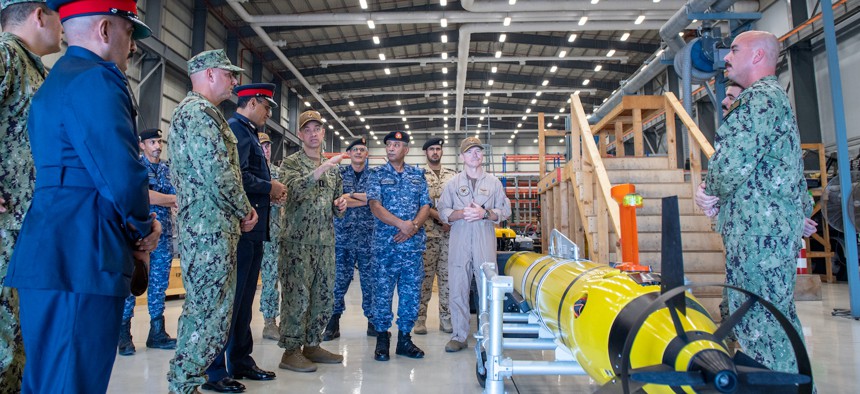
Vice Adm. Brad Cooper, commander of U.S. Naval Forces Central Command (NAVCENT), U.S. 5th Fleet and Combined Maritime Forces, center right, along with Major Gen. Ala Abdulla Seyadi, commander of the Bahrain Coast Guard, center left; and Rear Adm. Mohammed Yousif Al Asam, commander of the Royal Bahrain Naval Force, right, listen to a presentation on a Razorback unmanned underwater vehicle. U.S. Navy / Mass Communication Specialist 2nd Class Dawson Roth
Here’s the Last Hurdle Keeping Subs from Being Drone Motherships
The unmanned underwater vehicles need software that enables them to come back aboard via torpedo tube.
The U.S. Navy is working on software that will enable submarines to launch and recover underwater drones through torpedo tubes instead of using bulky, labor-intensive on-deck shelters.
“When this game-changing capability is deployed, every [attack submarine] will have the ability to serve as a UUV [unmanned underwater vehicle] mothership,” Rear Adm. Casey Moton, the program executive officer of unmanned and small combatants, said Wednesday at the Naval Submarine League’s 2022 annual symposium in Arlington, Virginia.
Today’s Razorback UUVs launch from a dry deck shelter that requires dozens of divers, Rear Adm. Doug Perry, the director of the Navy’s undersea warfare division, said Tuesday at the event. A new tube-launched version would require far less room in a sub’s packed confines.
“So the transition [to] torpedo-tube launch and recovery is huge. We've got 200 torpedo tubes in the fleet. We want to leverage as many of those as possible across our platforms to get down to the ocean floor as necessary,” Perry said.
“What a UUV does is just like a [unmanned aerial vehicle] does, it can serve as a scout, do missions that you do not want the manned platform to do,” Vice Adm. William Houston, the commander of naval submarine forces, told reporters Tuesday. “So essentially, we can go out and we can use these UUVs to scan, search, do other things for us, come back to the submarine, and we're not using a tremendous number of torpedo stows for that.”
The final hurdle is writing software to allow a deployed drone to maneuver itself back into the flooded tube “and to get a bull's eye every single time,” Houston said.
“It's very complex because the submarine is moving, the UUV is moving, you're using sensors to drive it into a very narrow tube on a moving platform with sea current going against it,” he said. “So it is challenging. We have world-class organizations working with us to solve this. And we have had great success, and we're ready to do our final demos coming up.”
Houston did not say when those demonstrations would take place.
The Navy is working with “two people” on the “special proprietary software” to do the drone recovery and it can be used on other UUVs once it’s ready, Houston said.




